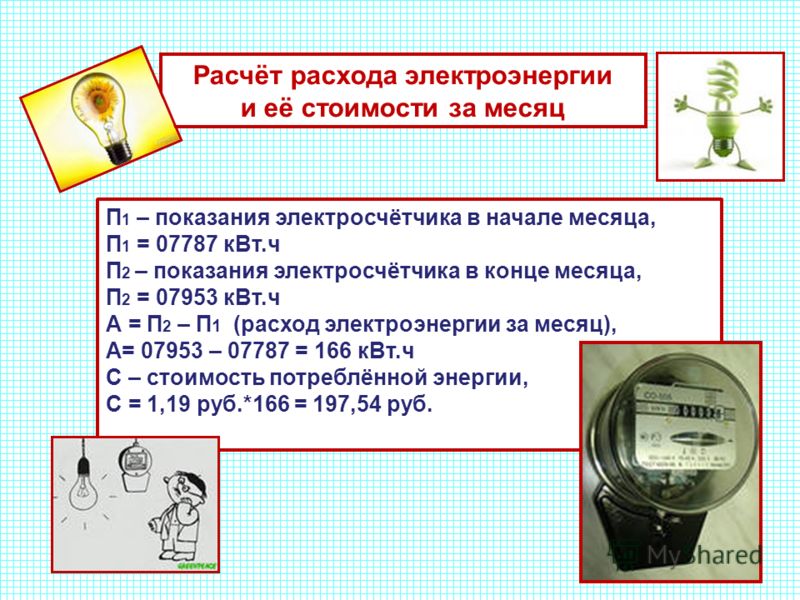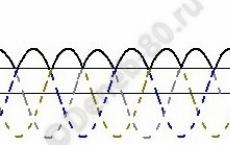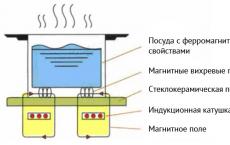It is hard to imagine our life without reliable helpers - electrical appliances. With their help, they bake bread and cook food, store food and clean the room. Without electrical appliances, we would not be able to quickly transmit and receive information, for example, get acquainted with technical achievements, sports and film news, weather forecasts. They help to process a variety of materials, illuminate the room and streets and perform many other useful work. Consider Figure 183 and explain which electrical appliances are depicted on it, what they are for. What is common between them and what is the difference? What kind of appliances does your family use?
Fig. 183. The use of electrical appliances in everyday life
Yes! Common to all household electrical appliances is that they operate at the expense of electric energy. Devices that work due to electric energy and are used in everyday life to facilitate the performance of certain works, create comfortable conditions for work and rest, are called household electrical appliances.
In the lessons of labor training and in the future in everyday life, you will use, or, you may already use a variety of similar electrical devices. To do this, you need to know the purpose of such devices, the principle of their operation and, most importantly, the rules for the safe use of them. Regardless of the purpose, in every household electrical appliance there is an element that consumes electrical energy to drive its working part. For example: in an electric drill, electric energy drives the engine, on the shaft of which a drill is fixed, in a electric jigsaw - a nail file, in a meat grinder - knives, in a washing machine - a drum with linen, etc. Since such devices work due to the consumed electric energy , they are all called consumers.
Depending on the purpose, principle of operation and design, household electrical appliances are divided into types and types. The most common types according to the principle of action are the following: electric lighting, electric heating, electromechanical.
Each type can have several types. For example: the type of device is electric lighting, and its types: floor lamp, sconce, chandelier, table lamp. Another group is heating electric appliances, and their types: electric stove, electric iron, electric coffee maker, etc.
Electromechanical include electric meat grinders, food processors, sewing and washing machines, screwdrivers, electric drills and much more (Fig. 184). With the long-term use of household electrical appliances, various types of malfunctions can occur. The most common include: self-loosening of clamping screws, with the help of which conductive conductors of electric cartridges, plugs, sockets are attached; breaking wires; failure of electrical and mechanical parts of devices, etc. As a result of this, sparking may occur, heating of wires, melting of insulation can be observed, resulting in a fire, failure of electrical devices (Fig. 185).

Fig. 184. Types of household electrical appliances

Fig. 185. Possible malfunctions electrical equipment
The use of faulty electrical appliances can lead to electric shock and, as a result, can lead to serious health consequences. To prevent this, the following safety rules must be observed:
- Before using the appliance, carefully read the instructions that came with each appliance.
- Use the appliance only with permission and in the presence of adults.
- It is forbidden to touch the levers, buttons of equipment located in the workshop, and turn them on.
- Do not check for voltage in electrical circuittouching bare wires with fingers.
- For any minor actions electric current on the body (tingling, warming) and if a sign of damage to the wiring, the smell of a melting insulating sheath of wires, the appearance of smoke is detected, the electric current source must be turned off and the teacher should be informed immediately, and when doing work at home, to adult family members.
- When using electrical appliances, it is necessary to ensure that the conductive wires are not taut and do not twist.
- To prevent electric shock to a person, when you turn on electrical appliances in an electric current network, it is forbidden to hold metal pipes for water heating, the wall of a building, or the body of another person with your hand (Fig. 186).
- Do not hold or pull. electric plug from the outlet using a cord (Fig. 187).
- In order to avoid electric shock, it is forbidden to touch bare wires with your hands, to perform any work with consumers connected to the electric current network or other power sources (Fig. 188).
- If another person is injured by electric shock, it is necessary to put a rubber mat or a stand made of dry wood under your feet and with one hand pull the victim by the collar or other part of the dry clothes from the electrical conductive network (Fig. 189).
- If electric wires get into the falling zone, it is urgent to get out of it, not jumping, but in small steps, moving the feet of the feet, without taking them off the road, as shown in Figure 190.

Fig. 186. Possible cases of electric shock

Fig. 187. Incorrect pulling of the plug from the outlet


Fig. 189. Method for the release of the victim

Fig. 190. Exit from the zone of incidence of the electric wire
New terms
electrical engineering, sources of electrical energy, consumers of electrical energy, household electrical appliances.
Basic concepts
- Sconces - wall lamp or lamp holder.
- Chandelier – hanging lamphaving multiple light sources.
- Floor lamp - lamp on a high stand.
Material fastening
- What types and types of household electrical appliances are divided into?
- What is common and what is the difference between types and types of electrical appliances?
- What safety rules must be observed when using household electrical appliances?
Test tasks
1. Why is it necessary to save electric energy?
- And to avoid the failure of household appliances
B to reduce energy costs
In order to reduce the cost of natural resources for its production
2. What household appliances are powered by electricity?
- A chandelier
B hair dryer
In a meat grinder
3. Using defective electrical appliances may result in
- A waste of electrical energy
Used by electric shock
In the failure of an electrical appliance
4. Why can not you touch bare wires?
- And the electrical appliance will fail
B. the power supply will stop
In can get electric shock
It is hard to imagine our life without reliable helpers - electrical appliances. With their help, they bake bread and cook food, store food and clean the room. Without electronic devices, we would not be able to quickly transmit and receive information, for example, get acquainted with technical achievements, sports and cinema news, weather forecasts. They help to process a variety of materials, illuminate the room and streets and perform many other useful work.
Devices that work due to electric energy and are used in everyday life to facilitate the performance of certain works, create comfortable conditions for work and leisure, are called household electrical appliances.
In the lessons of labor training and in the future in everyday life, you will use, or perhaps already use, a variety of similar electrical devices. To do this, you need to know the purpose of such devices, the principle of their action and, most importantly, the rules for the safe use of them.
Regardless of the purpose, in every household electrical appliance there is an element that consumes electrical energy to drive its working part. For example: in an electric drill, electric energy drives a motor, on the shaft of which a drill is fixed, in a electric jigsaw - a nail file, in a meat grinder - knives, in a washing machine - a drum with linen, etc. Since such devices work due to the consumed electric energy, they are all called by consumers.
Depending on the purpose, principle of operation and construction, household electrical appliances are divided into types and types .
The most common types of action are as follows: electric lighting, electric heating, electromechanical.
Each type may have several species. For example: device type electric lighting, and its types: floor lamp, sconce, chandelier, table lamp. Another group - heating electric appliances, and their types: electric stove, electric iron, electric coffee maker, etc.
TO electromechanicalinclude electric meat grinders, food processors, sewing and washing machines, screwdrivers, electric drills and much more (Fig. 184).
With the long-term use of household electrical appliances, various types of malfunctions can occur. The most common include: self-unscrewing of clamping screws, with the help of which conductive conductors of electric cartridges, plugs, sockets are attached; breaking wires; failure of the electrical and mechanical parts of devices, etc. As a result of this, sparking may occur, heating of wires, melting of insulation can be observed, resulting in a fire, failure of electrical devices (Fig. 185).
The use of faulty electrical appliances can lead to electric shock and, as a result, can lead to serious health consequences.
To prevent this, the following safety rules must be observed:
1. Before using the appliance, carefully read the instructions that came with each appliance.
2. Use the appliance only with permission and in the presence of adults.
3. It is forbidden to touch levers, buttons of equipment placed in the workshop, and turn them on.
4. You can not check for voltage in the electrical circuit by touching the bare wires with your fingers.
5. For any minor effects of electric current on the body (tingling, warming) and if a sign of damage to the wiring, the smell of a melting insulating sheath of wires, or the appearance of smoke is detected, it is necessary to turn off the source of electric current and immediately inform the teacher, and when performing work at home to adult family members.
6. When using electrical appliances, it must be ensured that the conductive wires are not taut and do not twist. Material from the site
 |
| Fig. 189. Method for the release of the victim |
7. To prevent electric shock to a person, when you turn on electrical appliances in an electric current network, it is forbidden to hold metal pipes for water heating, the wall of a building, or the body of another person with your hand (Fig. 186).
8. It is forbidden to hold or pull out an electric plug from the socket with a cord (Fig. 187).
9. In order to avoid electric shock, it is forbidden to touch exposed wires with your hands, to carry out any work when consumers are connected to an electric current network or other power sources (Fig. 188).
10. If another person is injured by electric shock, it is necessary to put a rubber rug or a stand made of dry wood under your feet and with one hand pull the victim by the collar or other part of dry clothes from the electrical conductive network (Fig. 189).
11. If electric wires get into the fall zone, it is urgent to get out of it, not jumping, but in small steps, moving the soles of the feet without taking them off the road, as shown in Figure 190.
Did not find what you were looking for? Use the search
On this page, material on topics:
- essay about household appliances
- essay on electric lighting
- rules for using household appliances
- rules for the safe use of household appliances
- composition about homework household appliances











Consumer power Fridge300 W Electric fireplace1000 W Iron1000 W Samovar1250 W Microwave 1300 W Toaster800 W Fan20 W TV75 W Hair dryer1200 W DVD player14 W Mixer, coffee grinder80 W Electric razor6 W Kettle W Blender400 W Electric grinder W Refrigerator Iron Fan Refrigerator Fireplace Electric shaver oven fan Table lamp Samovar microwave oven

Calculation of electricity consumption and its cost per month P 1 - meter readings at the beginning of the month, P 1 \u003d kWh; P 2 - meter readings at the end of the month, P 2 \u003d kWh A \u003d P 2 - P 1 (power consumption per month ), A \u003d - \u003d 166 kWh C - the cost of energy consumed, C \u003d 1.19 rubles. * 166 \u003d 197.54 rubles.

The use of energy-saving technologies in everyday life do not include lighting and electric heaters without the need; Use the economical mode of operation of household appliances; When leaving the apartment, make sure that all electrical appliances are turned off; use energy-saving lamps for lighting.

Safety rules for household appliances 1. Do not pull the plug by the wire from the outlet. When turning off the appliance, hold the socket body with your hand. 2. Ensure that the electrical cable (cord) is protected against accidental damage. 3. Ensure that cables or wires do not come into contact with metal, hot, wet, or oily surfaces or objects. 4. Avoid pulling and twisting the cable (cord). 5. Turn on the electrical equipment only after it is installed in the working position. 6. Protect electrical equipment from bumps, falls, dirt and water getting into it. 7. If there is a smell or smoke, loud noise or vibration, immediately disconnect the electrical system from the power supply. 8. It is forbidden: to independently open and repair live electrical appliances; leave unattended electrical equipment.


 Car generator and how to check it
Car generator and how to check it Safe use of household electrical appliances
Safe use of household electrical appliances Economical Electric Cookers
Economical Electric Cookers